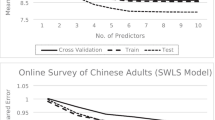Abstract
Although there are problems associated with thepractice of deriving weighted satisfactionscores by multiplying importance ratings andsatisfaction ratings of life domains, theseproblems do not seem sufficient to justify theabandonment of incorporating domain importanceweighting into quality of life (QoL)instruments. This paper shows that domainimportance as a weighting mechanism in QoLinstruments can be conceptually,psychometrically and empirically reasonable. Given the lack of conceptual or theoreticaldevelopment regarding the role of domainimportance in QoL instruments, it is importantto focus our attention on how to weight.
Similar content being viewed by others
REFERENCES
Agresti, A. and B. Finlay: 1997, Statistical Methods for the Social Sciences, 3rd ed. (Upper Saddle River, Prentice Hall, NJ).
Beatty, P. and S.A. Tuch: 1997, ‘Race and life satisfaction in the middle class’, Sociological Spectrum 17, pp. 71-90.
Bollen, K. and R. Lennox: 1991, ‘Conventional wisdom on measurement: A structural equation perspective’, Psychological Bulletin 110, pp. 305-314.
Campbell, A., P.E. Converse and W.L. Rogers: 1976, The Quality of American Life: Perceptions, Evaluations, and Satisfactions (Russel Sage, New York).
Chin, W.W. and P.R. Newsted: 1999, ‘Structural equation modeling analysis with small samples using partial least squares’, in R.H. Hole (ed.), Statistical Strategies for Small Sample Research (Sage, Thousand Oaks, CA), pp. 307-341.
Cohen, P., J. Cohen, J. Teresi, M. Marchi and C.N. Velez: 1990, ‘Problems in the measurement of latent variables in structural equations casual models’, Applied Psychological Measurement 14, pp. 183-196.
Cummins, R.A.: 1995, ‘On the tale of gold standard for life satisfaction’, Social Indicators Research 35, pp. 179-200.
Cummins, R.A.: 1996, ‘The domains of life satisfaction: An attempt to order chaos’, Social Indicators Research 38, pp. 303-328.
Cummins, R.A., M.P. McCabe, Y. Romeo and E. Gullone: 1994, ‘The comprehensive quality of life scale: Instrument development and psychometric evaluation on tertiary staff and students’, Educational and Psychological Measurement 54, pp. 372-382.
Diener, E.: 1984, ‘Subjective well-being’, Psychological Bulletin 95, pp. 542-575.
Ferrans, C.E.: 1990, ‘Development of a quality of life index for patients with cancer’, Oncology Nursing Forum 17(3), pp. 15-19.
Ferrans, C.E. and M.J. Powers: 1985, ‘Quality of life index: Development and psychometric properties’, Advances in Nursing Science 8(1), pp. 15-24.
Feist, G.J., T.E. Bodner, J.F. Jacobs, M. Miles and V. Tan: 1995, ‘Integrating top-down and bottom-up structural models of subjective well-being: A longitudinal investigation’, Journal of Personality and Social Psychology 68, pp. 138-150.
Headey, B., R. Veenhoven and A. Wearing: 1991, ‘Top-down versus bottom-up theories of subjective well-being’, Social Indicators Research 24, pp. 81-100.
Hsieh, C.M.: 2003, ‘Counting importance: The case of life satisfaction and relative domain importance’, Social Indicators Research 61, pp. 227-240.
Inglehart, R.: 1978, ‘Value priorities, life satisfaction, and political dissatisfaction among western publics’, Comparative Studies in Sociology 1, pp. 173-202.
Lance, C.E., G.J. Lautenschlager, C.E. Sloan and P.E. Varca: 1989, ‘A comparison between bottom-up, top-down, and bidirectional models of relationships between global and life facet satisfaction’, Journal of Personality 57, pp. 601-624.
Mastekaasa, A.: 1984, ‘Multiplicative and additive models of job and life satisfaction’, Social Indicators Research 14, pp. 141-163.
Mookherjee, H.N.: 1992, ‘Perceptions of well-being by metropolitan and nonmetropolitan populations in the United States’, Journal of Social Psychology 132, pp. 513-524.
Ryff, C.D. and M.J. Essex: 1992, ‘The interpretation of life experience and well-being: The sample case of relocation’, Psychology and Aging 7, pp. 507-517.
Scherpenzeel, A. and W. Saris: 1996, ‘Causal direction in a model of life satisfaction: The top-down/bottom-up controversy’, Social Indicators Research 38, pp. 161-180.
Trauer, T. and A. Mackinnon: 2001, ‘Why are we weighting? The role of importance ratings in quality of life measurement’, Quality of Life Research 10, pp. 579-585.
Author information
Authors and Affiliations
Rights and permissions
About this article
Cite this article
Hsieh, Cm. To Weight or not to Weight: The Role of Domain Importance in Quality of Life Measurement. Social Indicators Research 68, 163–174 (2004). https://doi.org/10.1023/B:SOCI.0000025591.82518.ab
Issue Date:
DOI: https://doi.org/10.1023/B:SOCI.0000025591.82518.ab



